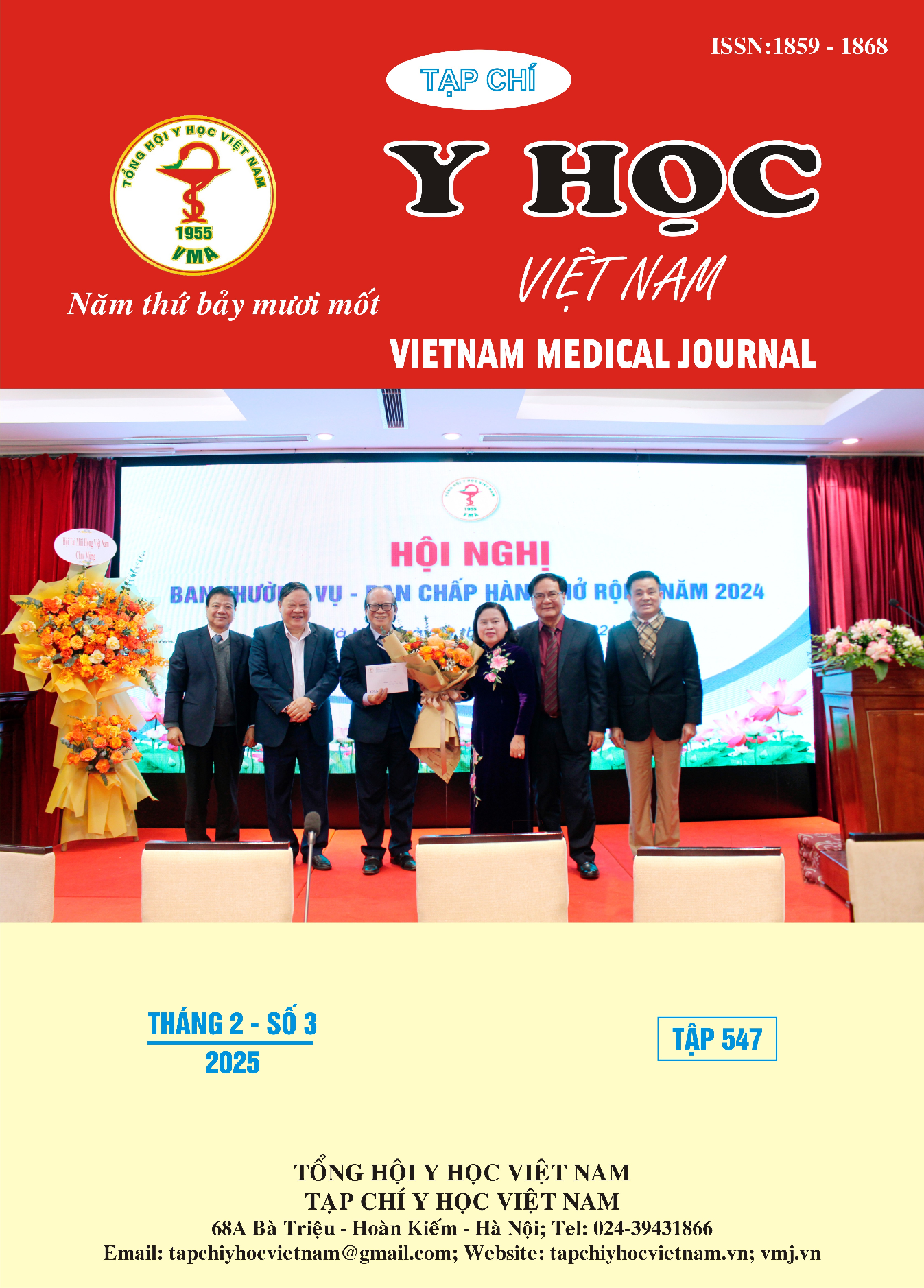SURGICAL OUTCOMES OF TRANSFORAMINAL LUMBAR INTERBODY FUSION (TLIF) FOR PATIENTS WITH OSTEOPOROTIC L4L5 SPONDYLOLITHESIS USING FENESTRATED CEMENT-AUGMENTED SCREWS AT VIET DUC HOSPITAL
Main Article Content
Abstract
Objective: To evaluate the outcomes of transforaminal lumbar interbody fusion (TLIF) surgery for L4L5 spondylolisthesis patients with osteoporosis using fenestrated cement-augmented screws at Viet Duc Hospital. Methods: A prospective descriptive study was conducted with 30 patients with lumbar spondylolisthesis and osteoporosis who underwent TLIF surgery using fenestrated cement-augmented screws at Viet Duc Hospital from January 2022 to June 2023. Results: Among the 30 patients in our study, the average surgery time was 79.9 ± 12.9 minutes. The average blood loss was 267.0 ± 46.9 ml. The average amount of cement injected into each vertebra was 3.0 ± 1.2 ml. The average hospital stay was 5.6 ± 1.8 days. Postoperatively, patients experienced a significant reduction in vertebral slippage and an improvement in interbody height compared to preoperative measurements, with p<0.05. At 12 months post-surgery, the decrease in interbody height compared to 1 month post-surgery was not statistically significant, with p>0.05. Patients' neurological symptoms significantly improved at 1, 6, and 12 months post-surgery. The VAS scores for lumbar spine and leg pain, as well as ODI scores, significantly decreased at 1, 6, and 12 months post-surgery, with a confidence level of P < 0.01. Immediately after surgery, only one patient (3.3%) developed a urinary tract infection, and one patient (3.3%) experienced superficial wound infection. At 12 months post-surgery, the screw loosening rate was 3.3%, and adjacent segment disease was 1.3%. The bone fusion rate was 80.0%, with no cases of non-union. Conclusion: TLIF surgery for L4L5 spondylolisthesis patients with osteoporosis using fenestrated cement-augmented screws is clinically effective, significantly improving VAS and ODI scores, achieving good correction outcomes, and demonstrating a high bone fusion rate. The rates of screw loosening and dislodgement are low, as are cement leakage and postoperative complications.
Article Details
Keywords
Lumbar spondylolithesis, osteoporotic, transforaminal lumbar interbody fusion (TLIF), fenestrated cement-augmented screws
References
1. Võ Văn Thanh (2014). Kết quả điều trị trượt đốt sống thắt lưng L4-L5 bằng phẫu thuật lấy đĩa đệm, cố định cột sống, ghép xương liên thân đốt. Luận văn tốt nghiệp Bác sỹ nội trú, Trường Đại học Y Hà Nội.
2. Parker, S.L, et al. Utility of minium clinically important difference in assessing pain, disability, and health state transforaminal lumbar interbody fusion for degenerative lumbar spondylolithesis. Journal of Neurosurgery. 2011;14(5):598-604.
3. Nguyễn Vũ (2015). Nghiên cứu điều trị trượt đốt sống thắt lưng bằng phương pháp cố định cột sống qua cuống kết hợp hàn xương liên thân đốt. Luận án Tiến sĩ Y học, Đại học Y Hà Nội.
4. Frankel BM, Jones T, Wang C. “Segmental poly- methylmethacrylate-augmented pedicle screw fixation in patients with bone softening caused by osteoporosis and metastatic tumor involvement: a clinical evaluation”. 2007, Neurosurgery 61:531–537 (discussion 537–538).
5. Manual Of Spine Surgery, Cement Augmentation of Pedicle Screw Fixation, Springer Heidelberg New York Dordrecht London, 351-359.
6. Dai F, Liu Y, Zhang F, et al. Surgical treatment of the osteoporotic spine with bone cement-injectable cannulated pedicle screw fixation: technical description and preliminary application in 43 patients. Clinics (Sao Paulo). 2015;70(2): 114 – 119.
7. Cho JH, Hwang CJ, Kim H, Joo YS, Lee DH, Lee CS. Effect of osteoporosis on the clinical and radiological outcomes following one-level posterior lumbar interbody fusion. J Orthop Sci. 2018 Nov;23(6):870-877.
8. Vaidya R, Sethi A, Bartol S, Jacobson M, Coe C, Craig JG. Complications in the use of rhBMP-2 in PEEK cages for interbody spinal fusions. J Spinal Disord Tech. 2008; 21:557-562.
9. Audat Z., Darwish F.T., Barbarwi M., et al. (2011). Surgical management of low grade isthmic spondylolithesis; a randomized cotrolled study of the surgical fixation with and without reduction. Scoliosis Journal, 6(14):1-6.


